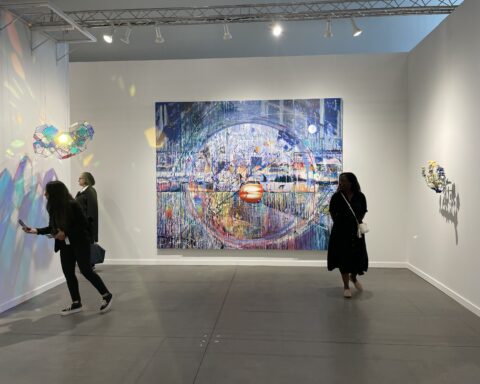
About 150 people filled a room in New York on an otherwise uneventful Wednesday evening in Greenwich Village to hear an American podcast host and a Hungarian curator discuss the intersection of fashion and architecture.
The crowd was keenly interested in the events of the evening and asked numerous thoughtful questions when the Q&A section came along after about an hour. The podcast host and the curator happily answered each question and patiently chatted with each guest who wanted further discussion after the event.
The above reference is to “Dress to Impress: The Intersection of Fashion and the Built Environment“, a two-person panel that was hosted by the American Institute of Architects (AIA) New York at the city’s Center For Architecture on February 21. Avery Trufelman, host of the popular fashion podcast Articles of Interest, and Andi Soos, a curator and a Ph.D. candidate in Design Culture Studies at the Moholy-Nagy University of Art and Design in Budapest, touched on topics both ephemeral and concrete in their quest to nail down how these two subjects intertwine and how both architects and those working in the fashion industry have collaborated throughout history.
It was a fascinating discussion, and it was the type of conversation that would be rare in other large cities in the United States.
New York has long been viewed as the center of America’s art, design, and culture industries – architecture and fashion included. But lately, many have taken it upon themselves to anticipate New York’s demise as a cultural hub due to such factors as the cost of living rising to the point of being untenable for many. With rising costs, the argument could validly be made that those in the creative professions are being priced out of the city – and that can’t be good for the long-term prospects of the City That Never Sleeps.
But if you’re looking for another city in the United States that is going to match New York in terms of dedication to discourse and thought leadership in the fashion industry, you will simply not find it. And this doesn’t mean that other cities in this country can’t contribute to the fashion industry as a whole; they contribute every single day in a variety of positions. New York, after all, can’t make up the entirety of the $343.70 billion estimated total that the fashion industry brings into the American economy.
However, given that the 180,000 people (that’s 6% of the city’s workforce, for those keeping track) who work in New York’s fashion industry bring in $11 billion in total wages, residents have a vested interest in seeing New York’s fashion industry succeed. There is a vested interest in promoting the discussion of theory and ideas in the public sphere as well as the practical application of those ideas in the form of the designs that end consumers see in stores & browse on websites and social media accounts.

When we take colleges and universities – where many future fashion professionals learn both fashion theory and design techniques – into consideration, New York is fortunate to have many fine schools at its fingertips. To be sure, having world-class institutions like Parsons, the Pratt Institute, and the Fashion Institute of Technology is a true advantage. Students who graduate from these institutions and choose to remain in New York are afforded the ability to continue nourishing the academic foundations of their fashion craft – an opportunity that students graduating from fashion schools in almost every other city in this country do not have because the impetus for these cities to help fashion professionals maintain that spirit of inquiry is simply not there.
With all of that said, New York’s fashion scene has seen a lot of ups and downs over the past couple of years – especially regarding the loss of young design talent, most recently the independent darling Puppets and Puppets. The US fashion industry cannot avoid that discussion. But in terms of the comprehensive American fashion industry, New York is still too big to fail. Imagine the catastrophe that fashion across the country would face if New York’s industry were to spiral further in a negative direction. The implications are, needless to say, not good.
For those who seem to take pleasure in New York’s fashion industry turbulence, it begs the question: are they aware of the enormity of the United States fashion industry? Have they considered the outsized ripple effect that a weakened New York would have on the rest of the country’s fashion designers, journalists, models, stylists, and other workers?
For those of us who are not leaving the United States for supposed greener pastures (as some have over the past few years), New York is still the main game in town – especially for those of us who are journalists or who have otherwise built their fashion careers primarily on the back of discourse.
What other city in the United States is going to create a welcoming environment for these necessary conversations – and what other city here contains a critical mass of people who care enough to take time out of their frenzied lives to engage in these discussions, regardless of what day of the week it is occurring upon?
With all due respect to other large cities in this country, there are none. New York is still the undisputed leader in both fashion thought leadership and fashion design – and the overall American fashion industry would not be able to withstand an extended downturn in New York’s fashion business.
To subscribe to Manic Metallic‘s Substack newsletter, click here. To follow us on Bluesky, click here.




